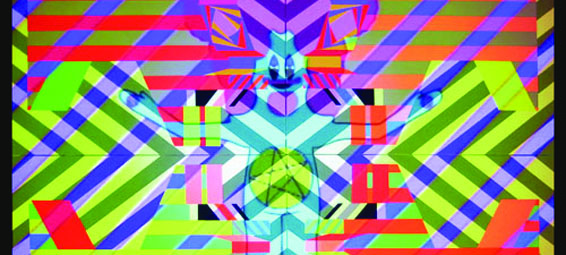Donkey Kong is for my generation what the madeleine was for Proust. The bright colors, jumpy video, and pixilation of 1980’s video games are so specific that one glimpse can provoke waves of nostalgia. Today of course this aesthetic is quaint and even primitive compared to the fine line that exists between the real and the virtual with Halo and Avatar.
But just as modernist artists like Picasso and Dubuffet looked to the “primitive” for greater purities of expression, a generation of artists like Cory Arcangel, Michael Bell Smith, Paul Slocum, and Ben Jones have been mining the aesthetics of retro-technology to step out of the mad rush to the future. In this sense they move away from the utilitarian function of technology and instead use it as a space for play and more oblique exploration.

Ben Jones’s Focus show, in three rooms at the Modern Art Museum of Fort Worth includes paintings, sculpture and video in DayGlo colors that flash and buzz like a mash up of Op art and psychedelia. But they also play on some subtle tensions between the real and the imagined.
The left and right walls of the central room are painted with diagonal grey stripes. On each wall there is a painted wooden trompe l’oeil sculpture of a ladder. Another ladder hangs on the top of the central wall and beneath it is a two-paneled painting. The top panel consists of three pyramids and a cube within a transparent polyhedron. In the bottom panel we can see a room in which a girl peeks through a hole in the floor. Above her is a table on which we can see a painted image of the pink, green and yellow ladder sculpture on the left wall. The rest of the depicted room is filled with abstract paintings and a set of stairs that seem to go off into nowhere.
Within the complex imagery of this gallery we can see a tension between two and three dimensions. The trompe l’oeil sculptures evoke both the tangible mass of reality and a projection into the imaginary. This is furthered by the depicted image of the ladder in the painting. The use of ladders and stairs in video games is often for the purpose of getting one to the next room or level. This is a definition of both progress and revelation. One is more likely to win by going somewhere else than staying in the same place. The image of the ladder becomes a symbol for this sense of spatial and possibly ontological transition.

There is a sculpture of a dog in the central room that is also painted four times on a canvas in the room on the right. Painted behind them are stripes that resemble early Frank Stella. Projected on top of this is a Gumby like figure whose belly is a revolving pentagram. Beside him there is a flashing image of two figures meditating in a lotus position like little yogis.
There are a great many symbols that populate this space and they are deeply linked to the use of geometry in various mystical traditions. Maybe this is why there is a vague ghost of the occult that haunts this work. Contrary to the happy biomorphic emanations of pysychedelia which Jones’s use of color might suggest, this use of geometry ties the crude pixilation of early video games to Masonic rituals and geometric abstraction.
The third gallery also combines painting with video projection. Four heads stare out from a striped background like totems. More than any other image in the exhibition this video painting embodies the tension between stasis and movement. But this tension is central to the work of Ben Jones who lives in the borderland between the real and the imaginary. Beyond the combination of painting and video, Jones performed at one of the opening nights of the exhibition with a drum kit and samples in front of a video projection. As the drums beats got louder and louder and the samples reached crescendo, repeating again and again, a lone blocky figure rose up on a cloud like a Hollywood hero transcending the limitations of an unknown plot. As I stood there watching Jones wail away at the drums with the video glowing behind him, I saw that painting, video games, music or sculpture were all ways to break free of stasis and jump into the imaginary.
Top image: Ben Jones, N.D.A. Video Painting 2, 2009 (detail), Acrylagouache on canvas with digital video, 72 x 92 inches (all images courtesy of the Modern Art Museum of Fort Worth)





